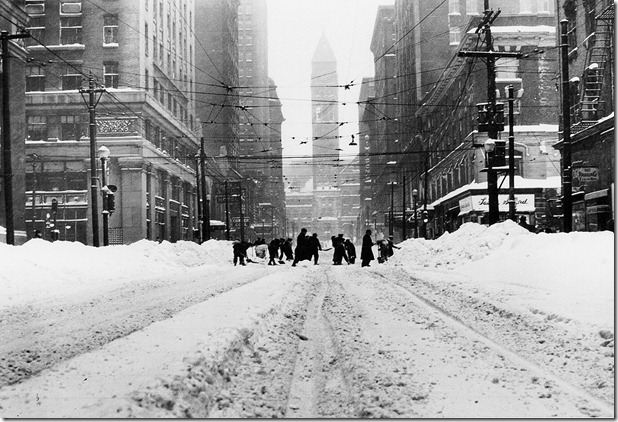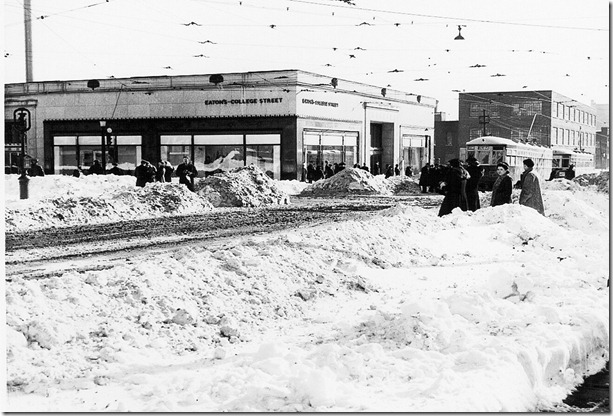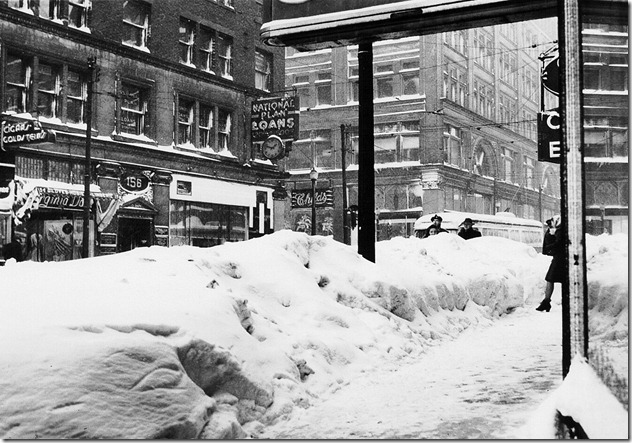This December, the weather in Toronto has been so mild that it is difficult to believe that we are into the yuletide season. However, Vancouver has been hit with so much snow that the city has had difficulties coping with the traffic snarls. In the past, Toronto has also endured some very heavy snowstorms.
Can you believe that this is Toronto? The above picture was taken in December of 1944, when the worst snowstorm to ever hit the city descended. The picture is of Bay Street, looking north to the Old City Hall on Queen Street. The men in the intersection are clearing the streets.
This is the intersection at Bay and College Streets. The building on the southeast corner is the Eaton’s College street Store, which has since been demolished. A Peter Witt streetcar can be seen travelling north on Bay Street. This photo, from the City of Toronto Archives, was also taken in December of 1944.
The above picture is Yonge street in December of 1944, looking north from near Richmond Street. The building seen behind the PCC streetcar is the Bay Store at Queen and Yonge Street.
The snowstorm of 1944 was the worst snowstorm in Toronto’s history. It was rare that stories linking Canada and snow were considered newsworthy. In other countries, they usually ranked them in the same category as an old bachelor’s love life—frigid, but who cares? However, this was an exception, as the event created newspaper headlines across North America.
A warm, moist air mass travelled for several days northward up the Mississippi Valley from the Gulf of Mexico. Its effects were first felt in Colorado; it continued northward, gradually spinning to the northeast. It reached northern New York State in the early evening of Monday, 11 December, sweeping westward below the Niagara Escarpment and across Lake Ontario. Then, changing direction, it approached Toronto from the east. Before it blew out to sea off the Atlantic seaboard, it created a wide swath of death and destruction.
Even today, lake-effect storms remain the city’s worst winter nightmare. The famous “storm of ’44” began on a Monday evening, when snow flurries scattered across the streets and laneways. Soon, its intensity increased. As midnight approached, the storm intensified. In the early hours of the morning of 12 December, Torontonians awoke to a wintry world beyond imagination. By 8:00 a.m., nineteen inches (nearly fifty centimetres) had fallen. The storm continued, and by 10:00 a.m., there were twenty inches, twenty-one by noontime. Before the storm abated in the afternoon, twenty-two and a half inches of snow had accumulated.
Because of the gale-force winds, drifts were six to ten feet high. The previous record snowfall was in 1876, with 16.2 inches (41.1 cm). During the snow crisis of 1999, when Mayor Mel Lastman called in the army, 15.5 inches (39.3 cm) fell. The 1944 storm still holds the record as the greatest amount of snow from a single storm.
When people awoke and gazed out their frost-covered windows, it appeared as if an enormous snow-filled dumpster had dropped its contents, burying the city. Streets and laneways were impassable, sidewalks were blocked with drifts, fences were buried, and most garden sheds had vanished beneath a thick layer of white. Other than the wind, the only sounds were the muffled clip-clops of a few horse carts whose owners foolishly braved the drifts.
One newspaper reporter wrote, “It’s as if a giant’s hand has silenced the city.”
On the radio, Mayor Conboy issues a request to the people of Toronto: “Remain within your homes, and do not travel to work unless necessary. Any available public transportation has been reserved for emergencies and those employed in the war industries, as their production is essential for victory. Cars are banned from roadways with streetcar lines. Get into the national spirit and help our city support the war effort.”
Despite these restrictions, it was hopeless. The city moved in slow motion. Hospitals were short staffed; they postponed surgeries. On the radio, Bell Telephone notified customers that no repair trucks were available and asked them to limit their phone calls. Funerals were cancelled. Milk and bread deliveries were impossible. Courts of justice were shut down when jurors failed to arrive. The Toronto Stock Exchange ceased operations.
At 11:30 a.m., Premier Drew adjourned the legislative session at Queen’s Park. It was announced, “All activity has ceased.”
On this subject, one newscaster commented, “What’s different? There’s rarely any activity even when the government is in session.”
Eaton’s and Simpson’s closed but vowed to open the following day. However, Eaton’s declared that if any customers arrived at their doors during the storm, they would escort them through the departments.
The University of Toronto suspended all classes for the day, as the campus was buried beneath six-foot drifts. Its ornate Gothic buildings resembled a deserted movie set—eerie, empty, and ghostly. Icy winds whistled through the doorways of the old buildings, bombarding the massive stone walls of University College, Convocation Hall, and Hart House. They wrapped around Memorial Tower, piling the snow under the massive archway. Tornado-like winds hammered the near-vacant quadrangle at the heart of the campus, where a few hearty students struggled through the snowbanks only to be confronted by empty lecture halls.
Officials closed public schools, though many parents were unaware of the announcement and sent their children to school, anyway. One principal reported that of the 530 pupils that normally attended the school, only 60 had arrived. Toronto’s one hundred thousand elementary school children and three thousand teachers had a winter holiday. High schools were in the middle of term examinations and had been scheduled to close on Friday for the Christmas break. Because of the storm, they decided to postpone the exams until the following Monday, the students relinquishing a day of their regular ten-day holidays.
It was indeed a snowstorm to remember.
The above information is from the book, “Arse Over Teakettle.” For a link to this book :https://tayloronhistory.com/arse-over-teakettle/
To view other posts about Christmas in Toronto throughout the years.
The Christmas butter sculptures in the lobby of the Royal York Hotel
https://tayloronhistory.com/2012/12/19/xmas-butter-sculptures-in-royal-york-hotel-lobby/
A popcorn man on the street in downtown Toronto during Christmas
https://tayloronhistory.com/2012/12/18/a-popcorn-man-in-toronto-during-christmas-2012/
Photos with the Eaton’s Santa in 1941 and 1943
https://tayloronhistory.com/2012/12/18/photos-with-eatons-santa-claus-in-1941-and-1944/
A church Christmas pageant in Toronto in 2012
https://tayloronhistory.com/2012/12/17/church-xmas-concerts-of-yesteryear-remain-alive-in-toronto/
Downtown Toronto’s lights and Christmas displays – 2012
https://tayloronhistory.com/2012/12/17/downtown-torontos-xmas-displays-at-night/
The Christmas windows at the Bay Store are magical at night
https://tayloronhistory.com/2012/12/16/the-bay-xmas-windows-on-queen-become-magical-at-night/
Christmas at the historic St. Lawrence Market in 1921 and in 2012
https://tayloronhistory.com/2012/12/14/xmas-at-the-historic-st-lawrence-market-in-1921-and-in-2012/
The Christmas windows at the Bay Store on Queen Street, 2012
https://tayloronhistory.com/2012/12/12/the-2012-christmas-windows-at-the-bay-store-on-queen-street/
The amazing gingerbread houses on the underground Pathway in Toronto
https://tayloronhistory.com/2012/12/12/amazing-christmas-gingerbread-houses-on-torontos-pathway/
The gigantic metallic reindeer in the Eaton Centre
https://tayloronhistory.com/2012/12/13/the-gigantic-xmas-reindeer-in-the-eaton-centre/
Christmas cards mailed in Toronto during the years 1924-1926
https://tayloronhistory.com/2012/12/11/xmas-cards-mailed-in-toronto-1924-1927/
The Christmas buffet lunch at the Arcadian Court at the Simpson’s Queen Street Store in Toronto (the Bay)
Christmas at Mackenzie House on Bond Street.
https://tayloronhistory.com/2011/12/07/torontos-mackenzie-house-on-bond-street-at-christmas/
Christmas at Toronto’s St. Lawrence Market
https://tayloronhistory.com/2011/12/09/christmas-at-the-st-lawrence-market-in-torontos-yesteryear/
The Christmas Market at the Distillery District
Memories of the Christmas windows of the Simpson’s store on Queen Street
Christmas at the Kensington Market
https://tayloronhistory.com/2011/12/01/enjoying-the-kensington-market-at-christmas/
Memories of Toyland on the fifth floor of the old Eaton’s Store at Queen and Yonge Street
https://tayloronhistory.com/2011/11/29/memories-of-eatons-toyland-in-the-1940s/
The Christmas lights on Yonge Street in the 1950s
The history of Toronto’s Santa Claus Parade
https://tayloronhistory.com/2011/11/15/history-of-torontos-santa-claus-parade/
The 1940s Christmas radio broadcasts featuring Santa Claus
Christmas at Toronto’s historic St. Andrew’s Market
Christmas trees and seasonal decorations in Toronto
Celebrating the 12 days of Christmas in old Newfoundland
A humorous account of a Christmas concert in old Newfoundland
Link to the Home Page for this blog: https://tayloronhistory.com/



I worked in Simpsons Display Dept. in the late 60èrs and early 70èrs where doing the Christmas Windows was the highligth of the year. I have lived in Denmark since, but returned to Toronto in Dec. 2013, and rearly only found the old fashion Christmas in the Bay. The Eaton center did something very modern and there was no Christmas spirit in that. There was not even a Christmas tree at the Union Station, rearly nowhere else than in front of the city hall, and that being a bad one.
A far cry from 1966 – 1974.
Ove Mogensen, Copenhagen, Denmark.